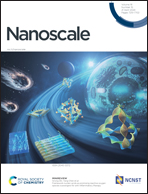Elevated temperature-driven coordinative reconstruction of an unsaturated single-Ni-atom structure with low valency on a polymer-derived matrix for the electrolytic oxygen evolution reaction†
Abstract
A high-temperature pyrolysis-controlled coordination reconstruction resulted in a single-Ni-atom structure with a Ni–Nx–C structural unit (x = N atom coordinated to Ni). Pyrolysis of Ni-phen@ZIF-8-RF at 700 °C resulted in NiNP-NC-700 with predominantly Ni nanoparticles. Upon elevating the pyrolysis temperature from 700 to 900 °C, a coordination reconstruction offers Ni–Nx atomic sites in NiSA-NC-900. A combined investigation with X-ray absorption spectroscopy, X-ray photoelectron spectroscopy, and soft X-ray L3-edge spectroscopy suggests the stabilization of low-valent Niδ+ (0 < δ < 2) in the Ni–N–C structural units. The oxygen evolution reaction (OER) is a key process during water splitting in fuel cells. However, OER is a thermodynamically uphill reaction with multi-step proton-coupled electron transfer and sluggish kinetics, due to which there is a need for a catalyst that can lower the OER overpotentials. The adsorption energy of a multi-step reaction on a single metal atom with coordination unsaturation tunes the adsorption of each oxygenated intermediate. The promising OER activity of the NiSA-NC-900/NF anode on nickel foam was followed by the overall water splitting (OWS) using using NiSA-NC-900/NF as anode and Pt coil as the cathodic counterpart, wherein a cell potential of 1.75 V at 10 mA cm−2 was achieved. The cell potential recorded with Pt(−)/(+)NiSA-NC-900/NF was much lower than that obtained for other cells, i.e., Pt(−)/NF and NF(−)/(+)NF, which enhances the potentials of low-valent NiSAs for insightful understanding of the OER. At a constant applied potential of 1.61 V (vs. RHE) for 12 h, an small increase in current for initial 0.6 h followed by a constant current depicts the fair stability of catalyst for 12 h. Our results offer an insightful angle into the OER with a coordinatively reconstructed single-Ni-atom structure at lower valency (<+2).

- This article is part of the themed collection: Nanocatalysis


 Please wait while we load your content...
Please wait while we load your content...